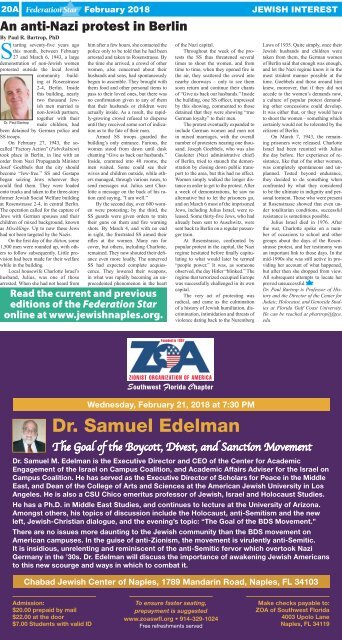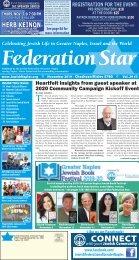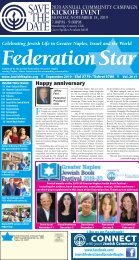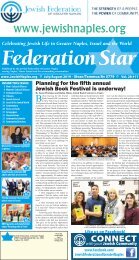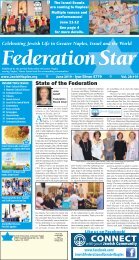Federation Star - February 2018
Monthly newspaper of the Jewish Federation of Greater Naples
Monthly newspaper of the Jewish Federation of Greater Naples
Create successful ePaper yourself
Turn your PDF publications into a flip-book with our unique Google optimized e-Paper software.
20A <strong>Federation</strong> <strong>Star</strong> <strong>February</strong> <strong>2018</strong><br />
An anti-Nazi protest in Berlin<br />
By Paul R. Bartrop, PhD<br />
<strong>Star</strong>ting seventy-five years ago<br />
this month, between <strong>February</strong><br />
27 and March 6, 1943, a large<br />
demonstration of non-Jewish women<br />
protested outside the local Jewish<br />
community building<br />
at Rosenstrasse<br />
2-4, Berlin. Inside<br />
this building, nearly<br />
two thousand Jewish<br />
men married to<br />
non-Jewish partners,<br />
together with their<br />
Dr. Paul Bartrop<br />
male children, had<br />
been detained by German police and<br />
SS troops.<br />
On <strong>February</strong> 27, 1943, the socalled<br />
“Factory Action” (Fabrikaktion)<br />
took place in Berlin, in line with an<br />
order from Nazi Propaganda Minister<br />
Josef Goebbels that the city should<br />
become “Jew-free.” SS and Gestapo<br />
began seizing Jews wherever they<br />
could find them. They were loaded<br />
onto trucks and taken to the three-story<br />
former Jewish Social Welfare building<br />
at Rosenstrasse 2-4, in central Berlin.<br />
The operation called for the capture of<br />
Jews with German spouses and their<br />
children of mixed background, known<br />
as Mischlinge. Up to now these Jews<br />
had not been targeted by the Nazis.<br />
On the first day of the Aktion, some<br />
1,500 men were rounded up, with others<br />
to follow subsequently. Little provision<br />
had been made for their welfare<br />
while in the building.<br />
Local housewife Charlotte Israel’s<br />
husband, Julius, was one of those<br />
arrested. When she had not heard from<br />
him after a few hours, she contacted the<br />
police only to be told that he had been<br />
arrested and taken to Rosenstrasse. By<br />
the time she arrived, a crowd of other<br />
women, also concerned about their<br />
husbands and sons, had spontaneously<br />
begun to assemble. They brought with<br />
them food and other personal items to<br />
pass to their loved ones, but there was<br />
no confirmation given to any of them<br />
that their husbands or children were<br />
actually inside. As a result, the rapidly-growing<br />
crowd refused to disperse<br />
until they received some sort of indication<br />
as to the fate of their men.<br />
Armed SS troops guarded the<br />
building’s only entrance. Furious, the<br />
women stood from dawn until dusk<br />
chanting “Give us back our husbands.”<br />
Inside, crammed into 40 rooms, the<br />
men waited. Some could see their<br />
wives and children outside, while others<br />
managed, through various ruses, to<br />
send messages out. Julius sent Charlotte<br />
a message on the back of his ration<br />
card saying, “I am well.”<br />
By the second day, over 600 women<br />
were protesting; by the third, the<br />
SS guards were given orders to train<br />
their guns on them and fire warning<br />
shots. By March 4, and with no end<br />
in sight, the frustrated SS aimed their<br />
rifles at the women. Many ran for<br />
cover, but others, including Charlotte,<br />
remained. They now shouted their defiance<br />
even more loudly. The unnerved<br />
SS had expected complete acquiescence.<br />
They lowered their weapons,<br />
in what was rapidly becoming an unprecedented<br />
phenomenon in the heart<br />
Read the current and previous<br />
editions of the <strong>Federation</strong> <strong>Star</strong><br />
online at www.jewishnaples.org.<br />
of the Nazi capital.<br />
Throughout the week of the protests<br />
the SS thus threatened several<br />
times to shoot the women, and from<br />
time to time, when they opened fire in<br />
the air, they scattered the crowd into<br />
nearby doorways – only to see them<br />
soon return and continue their chants<br />
of “Give us back our husbands.” Inside<br />
the building, one SS officer, impressed<br />
by this showing, commented to those<br />
detained that they were showing “true<br />
German loyalty” to their men.<br />
The protest eventually expanded to<br />
include German women and men not<br />
in mixed marriages, with the overall<br />
number of protesters nearing one thousand.<br />
Joseph Goebbels, who was also<br />
Gauleiter (Nazi administrative chief)<br />
of Berlin, tried to staunch the demonstration<br />
by closing down public transport<br />
to the area, but this had no effect.<br />
Women simply walked the longer distance<br />
in order to get to the protest. After<br />
a week of demonstrations, he saw no<br />
alternative but to let the prisoners go,<br />
and on March 6 most of the imprisoned<br />
Jews, including Julius Israel, were released.<br />
Some thirty-five Jews, who had<br />
already been sent to Auschwitz, were<br />
sent back to Berlin on a regular passenger<br />
train.<br />
At Rosenstrasse, confronted by<br />
popular protest in the capital, the Nazi<br />
regime hesitated before finally capitulating<br />
to what would later be termed<br />
“people power.” It was, as someone<br />
observed, the day Hitler “blinked.” The<br />
regime that terrorized occupied Europe<br />
was successfully challenged in its own<br />
capital.<br />
The very act of protesting was<br />
radical, and came as the culmination<br />
of a history of Jewish humiliation, discrimination,<br />
intimidation and threats of<br />
violence dating back to the Nuremberg<br />
JEWISH INTEREST<br />
Laws of 1935. Quite simply, once their<br />
Jewish husbands and children were<br />
taken from them, the German women<br />
of Berlin said that enough was enough,<br />
and let the Nazi regime know it in the<br />
most strident manner possible at the<br />
time. Goebbels and those around him<br />
knew, moreover, that if they did not<br />
accede to the women’s demands now,<br />
a culture of popular protest demanding<br />
other concessions could develop.<br />
It was either that, or they would have<br />
to shoot the women – something which<br />
certainly would not be tolerated by the<br />
citizens of Berlin.<br />
On March 7, 1943, the remaining<br />
prisoners were released. Charlotte<br />
Israel had been reunited with Julius<br />
the day before. Her experience of resistance,<br />
like that of the other women,<br />
was completely spontaneous and unplanned.<br />
Tested beyond endurance,<br />
they decided to do something when<br />
confronted by what they considered<br />
to be the ultimate in indignity and personal<br />
torment. Those who were present<br />
at Rosenstrasse showed that even under<br />
totalitarian conditions, successful<br />
resistance is sometimes possible.<br />
Julius Israel died in 1976. After<br />
the war, Charlotte spoke on a number<br />
of occasions to school and other<br />
groups about the days of the Rosenstrasse<br />
protest, and her testimony was<br />
an important link to those days. In the<br />
mid-1990s she was still active in providing<br />
her account of what happened,<br />
but after then she dropped from view.<br />
All subsequent attempts to locate her<br />
proved unsuccessful.<br />
Dr. Paul Bartrop is Professor of History<br />
and the Director of the Center for<br />
Judaic, Holocaust, and Genocide Studies<br />
at Florida Gulf Coast University.<br />
He can be reached at pbartrop@fgcu.<br />
edu.<br />
Founded in 1897<br />
ZIONIST ORGANIZATION OF AMERICA<br />
Southwest Florida Chapter<br />
Wednesday, <strong>February</strong> 21, <strong>2018</strong> at 7:30 PM<br />
Dr. Samuel Edelman<br />
The Goal of the Boycott, Divest, and Sanction Movement<br />
Dr. Samuel M. Edelman is the Executive Director and CEO of the Center for Academic<br />
Engagement of the Israel on Campus Coalition, and Academic Affairs Adviser for the Israel on<br />
Campus Coalition. He has served as the Executive Director of Scholars for Peace in the Middle<br />
East, and Dean of the College of Arts and Sciences at the American Jewish University in Los<br />
Angeles. He is also a CSU Chico emeritus professor of Jewish, Israel and Holocaust Studies.<br />
He has a Ph.D. in Middle East Studies, and continues to lecture at the University of Arizona.<br />
Amongst others, his topics of discussion include the Holocaust, anti-Semitism and the new<br />
left, Jewish-Christian dialogue, and the evening’s topic: “The Goal of the BDS Movement.”<br />
There are no issues more daunting to the Jewish community than the BDS movement on<br />
American campuses. In the guise of anti-Zionism, the movement is virulently anti-Semitic.<br />
It is insidious, unrelenting and reminiscent of the anti-Semitic fervor which overtook Nazi<br />
Germany in the ’30s. Dr. Edelman will discuss the importance of awakening Jewish Americans<br />
to this new scourge and ways in which to combat it.<br />
Chabad Jewish Center of Naples, 1789 Mandarin Road, Naples, FL 34103<br />
Admission:<br />
$20.00 prepaid by mail<br />
$22.00 at the door<br />
$7.00 Students with valid ID<br />
To ensure faster seating,<br />
prepayment is suggested<br />
www.zoaswfl.org • 914-329-1024<br />
Free refreshments served<br />
Make checks payable to:<br />
ZOA of Southwest Florida<br />
4003 Upolo Lane<br />
Naples, FL 34119


